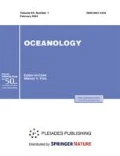Abstract
On cruise 76 in 2019, the R/V Akademik Mstislav Keldysh completed the Gulf of Ob–Kara Sea slope transect. Samples of bottom water and two sediment layers 1 cm thick were obtained with a multicorer. The silicon, mineral and total phosphorus, and organic nitrogen concentrations were measured in them. The magnitude of fluxes of these nutrients at the water–bottom boundary along the transect was calculated; they are all positive, i.e., directed from sediment to water. Comparison of silicon and phosphates fluxes obtained in the transect in 2019 with fluxes measured on a similar transect in 2007 showed good agreement. Silicon fluxes along the transect vary little (less than two times), including the frontal river–sea mixing zone. Mineral phosphorus fluxes have two maxima: in pure river waters and on the slope of the Kara Sea. In the area of the lens of freshened waters, phosphorus fluxes can have an alternating character, depending on season, the state of production, and destructive processes. A method is proposed for comparing fluxes of different nutrients in order to establish the nature of their variability along the transect and to identify measurement errors.




Similar content being viewed by others
REFERENCES
A. V. Vershinin and A. G. Rozanov, Chemical Exchange on the Interface Water-Bottom in the Oceans and Sea (GEOS, Moscow, 2002) [in Russian].
A. G. Zatsepin, P. O. Zavialov, V. V. Kremenetskiy, et al., “The upper desalinated layer in the Kara Sea,” Oceanology (Engl. Transl.) 50, 657–667 (2010).
S. A. Lapin, “Hydrological characterization of the Ob’ Inlet in the summer and autumn seasons,” Oceanology (Engl. Transl.) 51, 925–934 (2011).
S. A. Lapin, Candidate’s Dissertation in Geology (Moscow, 2012).
A. Yu. Lein, P. N. Makkaveev, A. S. Savvichev, et al., “Transformation of suspended particulate matter into sediment in the Kara Sea in September of 2011,” Oceanology (Engl. Transl.) 53, 570–606 (2013).
A. Yu. Lein, M. D. Kravchishina, N. V. Politova, et al., “Transformation of particulate organic matter at the water-bottom boundary in the Russian Arctic seas: evidence from isotope and radioisotope data,” Lithol. Miner. Resour. 47, 99–128 (2012).
P. N. Makkaveev and P. A. Stunzhas, “Hydrochemical characteristics of the Kara Sea basin,” Okeanologiya (Moscow) 34, 662–667 (1994).
A. G. Rozanov, “Redox system of the bottom sediments of the western Kara Sea,” Geochem. Int. 53, 987–1001 (2015).
Guide for Chemical Analysis of Marine and Fresh Waters during Ecological Monitoring of Fishery Reservoirs and Regions of the World Ocean, Prospective for Commercial Fishery, Ed. by V. V. Sapozhnikov (VNIRO, Moscow, 2003) [in Russian].
V. V. Stanovoi, “Variability of thermohaline structure of waters in the Kara Sea estuary,” Tr. Arkt. Antarkt. Nauchno-Issled. Inst. 448, 103–130 (2008).
P. A. Stunzhas and P. N. Makkaveev, “Volume of the Ob Bay waters as a factor of the formation of the hydrochemical inhomogeneity,” Oceanology (Engl. Transl.) 54, 583–595 (2014).
B. P. Boudreau, Diagenetic Models and Their Implementation. Modeling Transport and Reactions in Aquatic Sediments (Springer-Verlag, Berlin, 1997), Vol. 505.
Methods of Seawater Analysis, K. Grasshoff, K. Kremling, and M. Ehrhardt, 3rd ed. (Wiley, Chichester, 2009).
H. D. Schultz, “Quantification of early diagenesis: dissolved constituents in pore water and signals in the solid phase,” in Marine Geochemistry, Ed. by H. D. Schulz and M. Zabel, 2nd ed. (Springer-Verlag, Berlin, 2006), pp. 73–124.
Funding
The study was carried out under the state task of IO RAS (topic no. 0149-2019-0008) and Russian Science Foundation (project no. 19-17-00196 “Transformation of Dissolved Runoff in Estuarine Areas of Russian Rivers in Different Climatic Zones.”
Author information
Authors and Affiliations
Corresponding author
Additional information
Translated by Z. Litvinenko
APPENDIX
APPENDIX
Calculation of Nutrient Fluxes by the Example of Silicon Calculation for Station 6239
The concentration of H4SiO4 in the water column in contact with sediments (0 mm) is 8.12 µM; in pore water (10 mm), 206.96 µM.
The difference in concentrations between the two layers is 206.96–8.12 = 198.84 µM = 0.199 mol/m3.
The depth interval between two points is 10 mm (10–0) = 0.010 m.
The diffusion coefficient of silicon in seawater at a temperature of 2°C is 5 × 10–10 m2/s; phosphorus, 2.49 × 10–10 m2/s; nitrogen, 9.03 × 10–10 m2/ s [14].
The porosity of the upper sediment layer is taken according to [1].
The tortuosity of pore pathways is calculated by the formula θ = 1 – ln (ф2) [12]; for a porosity of 0.95, it is 1.1.
Thus, the diffusion coefficient in sediments (Ds) is 5 × 10–10/1.1 = 4.54 × 10–10.
For station 6239, the silicon flux (1) is
The flux is positive, from sediments.
Rights and permissions
About this article
Cite this article
Borisenko, G.V., Makkaveev, E.P. & Stunzhas, P.A. Concentration and Diffusion of Nutrients in the Interpore–Bottom Water System of the Ob River Estuary. Oceanology 61, 25–33 (2021). https://doi.org/10.1134/S0001437020060028
Received:
Revised:
Accepted:
Published:
Issue Date:
DOI: https://doi.org/10.1134/S0001437020060028




